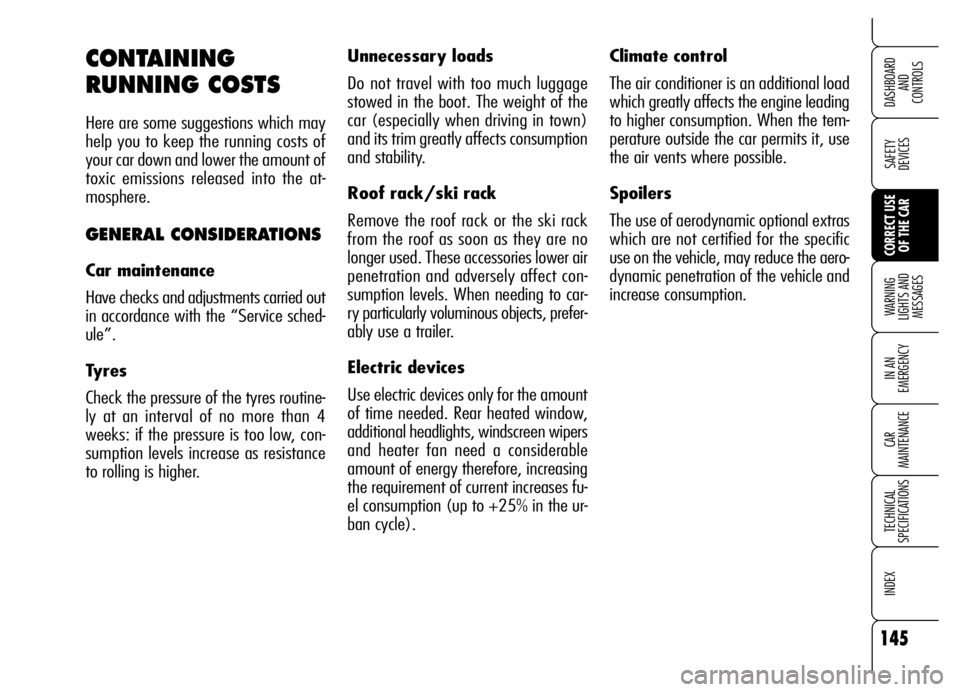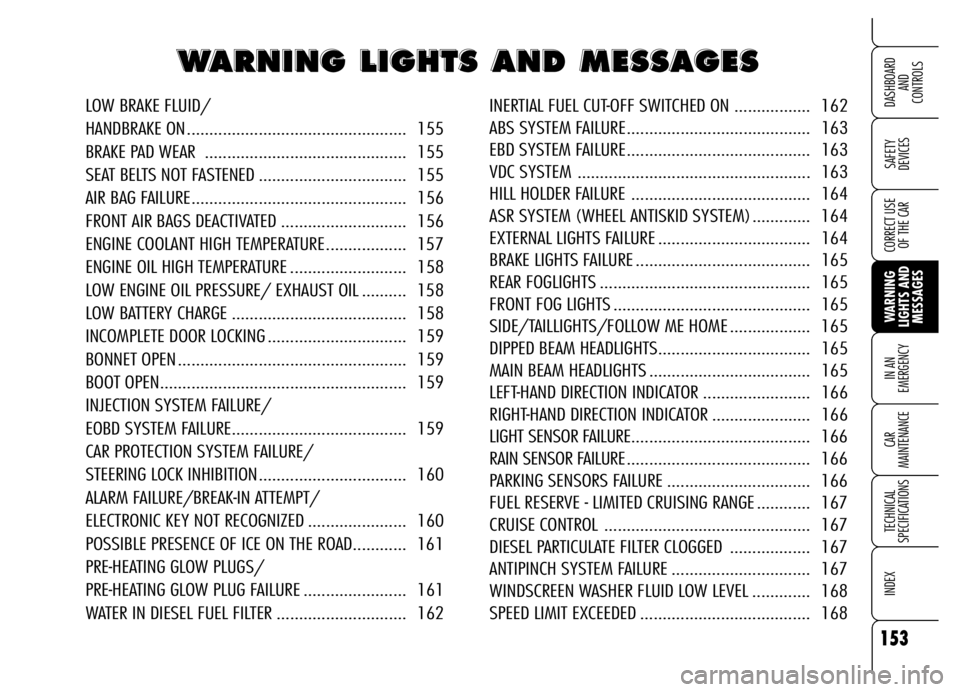2006 Alfa Romeo Brera/Spider oil pressure
[x] Cancel search: oil pressurePage 9 of 267

7
SAFETY
DEVICES
WARNING
LIGHTS AND
MESSAGES
IN AN
EMERGENCY
CAR
MAINTENANCE
TECHNICAL
SPECIFICATIONS
INDEX
DASHBOARD
AND
CONTROLS
CORRECT USE
OF THE CAR
DASHBOARD
A0F0056mfig. 1
1.Adjustable and swivel side air vents - 2. Front side window demisting/defrosting vents - 3.External lights control lever
- 4.Instrument panel - 5.Driver’s air bag and horn - 6.Windscreen wiper control lever - 7.Upper central vent - 8.Ad-
justable and swivel central air vents - 9.Fuel level gauge/engine coolant temperature gauge/engine oil temperature gauge
(petrol versions) or turbocharger pressure gauge (diesel versions) - 10.Passenger’s air bag - 11.Passenger’s knees air
bag (where provided) - 12.Glove box - 13.Sound system - 14.Heating/ventilation/climate controls - 15. Engine
START/STOPbutton - 16.Ignition device - 17.Driver’s knees air bag - 18.Sound system controls on the steering
wheel (where provided) - 19.Cruise Control lever (where provided) - 20.Bonnet opening lever - 21.Dashboard fusebox
lid - 22.Switches for external lights, trip meter reset and headlamp aiming device.
Page 26 of 267

24
SAFETY
DEVICES
WARNING
LIGHTS AND
MESSAGES
IN AN
EMERGENCY
CAR
MAINTENANCE
TECHNICAL
SPECIFICATIONS
INDEX
DASHBOARD
AND
CONTROLS
CORRECT USE
OF THE CARENGINE OIL TEMPERATURE
GAUGE
(petrol versions) fig. 17
This shows the temperature of the en-
gine oil and begins working when the
oil temperature exceeds approx. 70°C.
If the pointer reaches the red sector, re-
duce your demand on the engine.
A0F0179mfig. 17
The turning on of the warning light `
when travelling (together with a mes-
sage on the display) indicates that the
oil temperature is too high; in this case,
stop the engine and contact Alfa Romeo
Authorized Services.
IMPORTANTThe temperature of the
engine oil may rise towards the maxi-
mum values (red sector) when the car
is driven at low speeds, uphill, fully
laden or during towing, especially if the
ambient temperature is high.
A0F0180mfig. 18
TURBOCHARGER PRESSURE
GAUGE (diesel versions)
fig. 18
This shows the turbocharger pressure
value.
Page 27 of 267

25
SAFETY
DEVICES
WARNING
LIGHTS AND
MESSAGES
IN AN
EMERGENCY
CAR
MAINTENANCE
TECHNICAL
SPECIFICATIONS
INDEX
DASHBOARD
AND
CONTROLS
CORRECT USE
OF THE CAR
AUTOMATIC INSTRUMENT
PANEL LIGHT DIMMER
To give max. visibility and comfort un-
der whatever driving conditions (e.g.:
lights on in daylight, tunnels, etc…), the
speedometer is fitted with a sensor for
adjusting automatically, after fitting the
electronic key into the ignition device and
pressing button START/STOP, the
light intensity of the instrument panel dis-
play, sound system display, climate con-
trol system display, radionavigation sys-
tem display (where provided), and in-
struments (i.e.: fuel level gauge, engine
oil temperature gauge for petrol versions
or turbocharger pressure gauge for diesel
versions, and engine coolant temperature
gauge).
TRIP METER RESET fig. 19
To reset the trip meter, keep button A
pressed for a few seconds.
MANUAL INSTRUMENT
PANEL LIGHT DIMMER
With this function it is possible to adjust
on 8 levels the light intensity of the indi-
cations given on the instrument panel dis-
play, sound system display, climate con-
trol system display, radionavigation sys-
tem display (where provided), and in-
struments (i.e.: fuel level gauge, engine
oil temperature gauge for petrol versions
or turbocharger pressure gauge for diesel
versions, and engine coolant temperature
gauge).
To increase light intensity press briefly
button +on the left-hand stalk, to re-
duce it press button –: the display will
show an indication and a figure corre-
sponding to the current light intensity
level. This screen will be displayed for
a few seconds and then it will go off.
A0F0072mfig. 19
Page 147 of 267

145
SAFETY
DEVICES
WARNING
LIGHTS AND
MESSAGES
IN AN
EMERGENCY
CAR
MAINTENANCE
TECHNICAL
SPECIFICATIONS
INDEX
DASHBOARD
AND
CONTROLS
CORRECT USE
OF THE CAR
Climate control
The air conditioner is an additional load
which greatly affects the engine leading
to higher consumption. When the tem-
perature outside the car permits it, use
the air vents where possible.
Spoilers
The use of aerodynamic optional extras
which are not certified for the specific
use on the vehicle, may reduce the aero-
dynamic penetration of the vehicle and
increase consumption. Unnecessary loads
Do not travel with too much luggage
stowed in the boot. The weight of the
car (especially when driving in town)
and its trim greatly affects consumption
and stability.
Roof rack/ski rack
Remove the roof rack or the ski rack
from the roof as soon as they are no
longer used. These accessories lower air
penetration and adversely affect con-
sumption levels. When needing to car-
ry particularly voluminous objects, prefer-
ably use a trailer.
Electric devices
Use electric devices only for the amount
of time needed. Rear heated window,
additional headlights, windscreen wipers
and heater fan need a considerable
amount of energy therefore, increasing
the requirement of current increases fu-
el consumption (up to +25% in the ur-
ban cycle).CONTAINING
RUNNING COSTS
Here are some suggestions which may
help you to keep the running costs of
your car down and lower the amount of
toxic emissions released into the at-
mosphere.
GENERAL CONSIDERATIONS
Car maintenance
Have checks and adjustments carried out
in accordance with the “Service sched-
ule”.
Tyres
Check the pressure of the tyres routine-
ly at an interval of no more than 4
weeks: if the pressure is too low, con-
sumption levels increase as resistance
to rolling is higher.
Page 155 of 267

153
SAFETY
DEVICES
WARNING
LIGHTS AND
MESSAGES IN AN
EMERGENCY
CAR
MAINTENANCE
TECHNICAL
SPECIFICATIONS
INDEX
DASHBOARD
AND
CONTROLS
CORRECT USE
OF THE CAR
W W W W
A A A A
R R R R
N N N N
I I I I
N N N N
G G G G
L L L L
I I I I
G G G G
H H H H
T T T T
S S S S
A A A A
N N N N
D D D D
M M M M
E E E E
S S S S
S S S S
A A A A
G G G G
E E E E
S S S S
LOW BRAKE FLUID/
HANDBRAKE ON ................................................. 155
BRAKE PAD WEAR ............................................. 155
SEAT BELTS NOT FASTENED ................................. 155
AIR BAG FAILURE................................................ 156
FRONT AIR BAGS DEACTIVATED ............................ 156
ENGINE COOLANT HIGH TEMPERATURE.................. 157
ENGINE OIL HIGH TEMPERATURE .......................... 158
LOW ENGINE OIL PRESSURE/ EXHAUST OIL .......... 158
LOW BATTERY CHARGE ....................................... 158
INCOMPLETE DOOR LOCKING ............................... 159
BONNET OPEN ................................................... 159
BOOT OPEN....................................................... 159
INJECTION SYSTEM FAILURE/
EOBD SYSTEM FAILURE....................................... 159
CAR PROTECTION SYSTEM FAILURE/
STEERING LOCK INHIBITION................................. 160
ALARM FAILURE/BREAK-IN ATTEMPT/
ELECTRONIC KEY NOT RECOGNIZED ...................... 160
POSSIBLE PRESENCE OF ICE ON THE ROAD............ 161
PRE-HEATING GLOW PLUGS/
PRE-HEATING GLOW PLUG FAILURE ....................... 161
WATER IN DIESEL FUEL FILTER ............................. 162INERTIAL FUEL CUT-OFF SWITCHED ON ................. 162
ABS SYSTEM FAILURE......................................... 163
EBD SYSTEM FAILURE......................................... 163
VDC SYSTEM .................................................... 163
HILL HOLDER FAILURE ........................................ 164
ASR SYSTEM (WHEEL ANTISKID SYSTEM) ............. 164
EXTERNAL LIGHTS FAILURE .................................. 164
BRAKE LIGHTS FAILURE ....................................... 165
REAR FOGLIGHTS ............................................... 165
FRONT FOG LIGHTS ............................................ 165
SIDE/TAILLIGHTS/FOLLOW ME HOME .................. 165
DIPPED BEAM HEADLIGHTS.................................. 165
MAIN BEAM HEADLIGHTS .................................... 165
LEFT-HAND DIRECTION INDICATOR ........................ 166
RIGHT-HAND DIRECTION INDICATOR ...................... 166
LIGHT SENSOR FAILURE........................................ 166
RAIN SENSOR FAILURE......................................... 166
PARKING SENSORS FAILURE ................................ 166
FUEL RESERVE - LIMITED CRUISING RANGE ............ 167
CRUISE CONTROL .............................................. 167
DIESEL PARTICULATE FILTER CLOGGED .................. 167
ANTIPINCH SYSTEM FAILURE ............................... 167
WINDSCREEN WASHER FLUID LOW LEVEL ............. 168
SPEED LIMIT EXCEEDED ...................................... 168
Page 160 of 267

158
SAFETY
DEVICES
WARNING
LIGHTS AND
MESSAGES IN AN
EMERGENCY
CAR
MAINTENANCE
TECHNICAL
SPECIFICATIONS
INDEX
DASHBOARD
AND
CONTROLS
CORRECT USE
OF THE CAR
ENGINE OIL
HIGH TEMPERATURE
Fitting the key into the ignition
device, the warning light (set on engine
oil temperature gauge) turns on but it
should go off a few seconds later.
Warning light turning on when travelling
(together with the message on the dis-
play) indicates that engine oil is too hot;
switch the engine off and contact Alfa
Romeo Authorized Services.
LOW BATTERY
CHARGE (red)
If symbol w+ message are
displayed, contact immediately
Alfa Romeo Authorized Services.
w
`
If symbol v+ mes-
sage are displayed, con-
tact as soon as possible
Alfa Romeo Authorized Services
to have engine oil changed and
displayed symbol
vturned
off.
LOW ENGINE
OIL PRESSURE
EXHAUST OIL
(diesel versions)
Low engineoil pressure
If message + symbol are displayed when
travelling stop the engine immediately
and contact Alfa Romeo Authorized Ser-
vices.
Exhaust oil (diesel versions)
Message + symbol are displayed when
the system detects that the engine oil is
exhaust.
After the first indication, at each engine
starting the message + symbol will be dis-
played for about 1 minute and then every
2 hours until oil is changed.
v
If warning light `starts
flashing when travelling,
contact Alfa Romeo Au-
thorized Services.
Page 215 of 267

213
SAFETY
DEVICES
WARNING
LIGHTS AND
MESSAGES
IN AN
EMERGENCY
CAR
MAINTENANCE
TECHNICAL
SPECIFICATIONS
INDEX
DASHBOARD
AND
CONTROLS
CORRECT USE
OF THE CAR
USE OF THE CAR
UNDER HEAVY
CONDITIONS
Should prevailing use of the car be un-
der one of the following specially heavy
conditions:
❒trailer or caravan towing;
❒dusty roads;
❒short distances (less than 7-8 km)
and repeated with external temper-
atures below zero;
❒frequently idling engines or long dis-
tance low speed driving (e.g.: door-
to-door deliveries) or in case of a long
term inactivity;
❒urban routes;
carry out checks more frequently than
required on Service Schedule:
❒check front disk brake pad conditions
and wear;
❒check cleanness of bonnet and boot
locks and lever cleanness and lubri-
cation;
❒sight inspect the conditions of: en-
gine, gearbox, transmission, pipes
and hoses (exhaust - fuel - brakes),
rubber parts (boots, sleeves, bushes,
etc.);
❒check battery charge and fluid level
(electrolyte);
❒visual check on various drive belt con-
ditions;
❒change engine oil and oil filter, if re-
quired;
❒check and replace pollen filter, if re-
quired;
❒check and replace air cleaner, if re-
quired.
PERIODICAL CHECKS
Every 1,000 km or before long jour-
neys, check and top up if required:
❒engine coolant fluid level;
❒brake fluid level;
❒windscreen washer fluid level;
❒tyre pressure and conditions.
❒check light system operation (head-
lights, direction indicators, hazard
lights, etc.);
❒check windscreen wiper/washer op-
eration and windscreen/rear window
blade position/wear;
Every 3,000 km check and top up if re-
quired: engine oil level.
You are recommended to use FL Sele-
nia products, designed and produced
specifically for Alfa Romeo cars (see
table “Capacities” in section “Techni-
cal specifications”).
Page 261 of 267

fig. 1
1.Adjustable swivel side air vents -2.Front side window demisting/defrosting vents -3. Passenger’s air bag - 4.Fuel lev-
el gauge/engine coolant temperature gauge/engine oil temperature gauge (petrol versions) or turbocharger pressure
gauge (diesel versions) - 5.Adjustable swivel centre air vents - 6. Upper central vent - 7.External lights control lever -
8. Driver’s air bag and horn - 9.Instrument panel - 10. Windscreen wiper control lever - 11.Front side window demist-
ing/defrosting vents - 12.Adjustable swivel side air vents - 13. Switches for external lights, trip meter reset and headlamp
aiming device. - 14.Dashboard fusebox lid - 15.Bonnet opening lever - 16. Sound system controls on the steering wheel
(where provided) - 17.Driver’s knees air bag - 18.Cruise Control lever (where provided) - 19.Ignition device - 20.En-
gine START/STOPbutton - 21. Heating/ventilation/climate controls - 22. Sound system (where provided) - 23.
Glove box - 24. Passenger’s knees air bag (where provided)
DASHBOARD
259
RIGHT HAND DRIVE VERSION